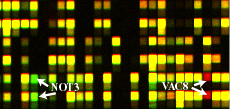
![]()
![]()
![]()
![]()
Enhanced Sporulation Efficiency Class
![]()
Post-Germination Growth Defective Class
![]()
![]()
![]()
![]()



PNAS. 99: 15530-15535 (2002)
Parallel phenotypic analysis of sporulation and postgermination growth in Saccharomyces cerevisiae
Adam M. Deutschbauer (1), Roy M. Williams (2), Angela M. Chu (3), Ronald W. Davis (1,3,4)
(1) Department of Genetics, and (3) Department of Biochemistry, Stanford University School of Medicine, Stanford, California 94305, USA
(2) Diversa Corporation, 4599 Directors Place, San Diego, California 92121, USA
(4) Stanford Genome Technology Center, 855 California Avenue, Palo Alto, California 94304, USA
Abstract
We have quantitatively monitored the sporulation and germination efficiencies of over 4200 yeast deletion strains in parallel using a molecular bar coding strategy. In a single study, we doubled the number of genes functionally implicated in sporulation to ~400, identifying both positive and negative regulators. Our set of 261 sporulation-deficient genes illustrates the importance of autophagy, carbon utilization, and transcriptional machinery during sporulation. These general cellular factors are more likely to exhibit fitness defects when deleted and less likely to be transcriptionally regulated than sporulation-specific genes. Our post-germination screening assay identified recombination/chromosome segregation genes, aneuploid strains, and possible germination-specific factors. Finally, our results facilitate a genome-wide comparison of expression pattern and mutant phenotype for a developmental process and suggest that 16% of genes differentially expressed during sporulation confer altered efficiency of spore production or defective post-germination growth when disrupted.